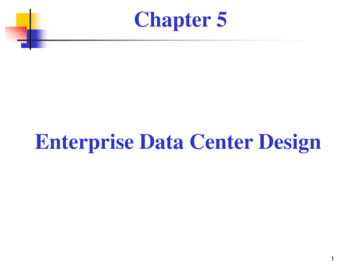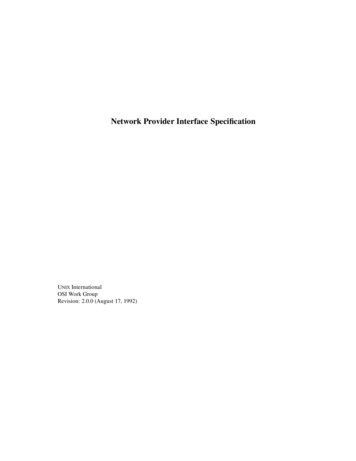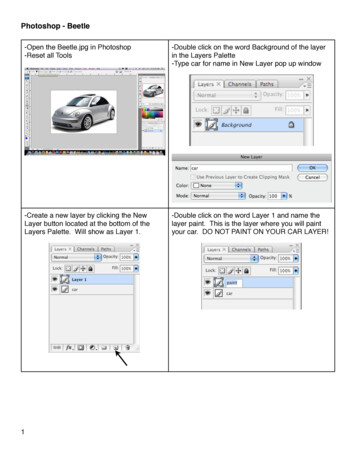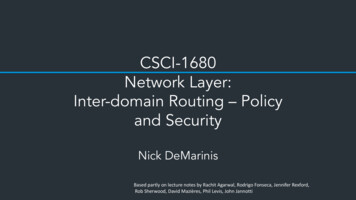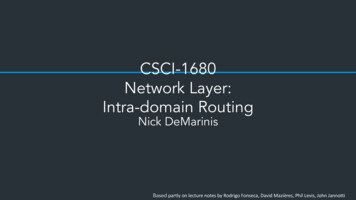
Transcription
CSCI-1680Network Layer:Intra-domain RoutingNick DeMarinisBased partly on lecture notes by Rodrigo Fonseca, David Mazières, Phil Levis, John Jannotti
Administrivia IP milestone meetings: Should meet with staff on/beforeMonday, March 7– Sign up link on website– Try to find a slot with your mentor, pick any slot if you can’t HW2: Out next week
Challenges in moving packets Forwarding: given a packet, decide which interface tosend the packet (based on IP destination) Routing: network-wide process of determining apacket’s path through the network
TodayRouting Intra-Domain Routing Next class: Inter-Domain Routing
Routing Routing is the process of updating forwarding tables– Routers exchange messages about routers or networks they canreach– Goal: find optimal route for every destination– or maybe a good route, or any route (depending on scale) Challenges– Dynamic topology– Decentralized– Scale
Scaling Issues Every router must be able to forward based on anydestination IP address– Given address, it needs to know next hop– Naïve: one entry per address– There would be 108 entries! Solutions– Hierarchy (many examples)– Address aggregation Address allocation is very important (should mirror topology)– Default routes
IP Connectivity For each destination address, must either:– Have prefix mapped to next hop in forwarding table– Know “smarter router” – default for unknown prefixes Core routers know everything – no default Manage using notion of Autonomous System (AS)
Internet structure, 1990NSFNET egional WestnetregionalUNMNCARISUUNLKUUA Several independent organizations Hierarchical structure with singlebackbone
Internet structure, todayLarge corporation“Consumer” ISPPeeringpointBackbone service provider“Consumer” ISPLarge corporationPeeringpoint“Consumer” ISPSmallcorporation Multiple backbones, more arbitrarystructure
Autonomous Systems Correspond to an administrative domain– AS’s reflect organization of the Internet– E.g., Brown, large company, etc.– Identified by a 16-bit number (now 32) Goals– AS’s choose their own local routing algorithm– AS’s want to set policies about non-local routing– AS’s need not reveal internal topology of their network
Map of the Internet, 2021 (via BGP)OPTE project11
Inter and Intra-domain routingRouting organized in two levels Intra-domain routing– Complete knowledge, strive for optimal paths– Scale to 100 networks– Today Inter-domain routing– Aggregated knowledge, scale to Internet– Dominated by policy E.g., route through X, unless X is unavailable, then route through Y. Never routetraffic from X to Y– Policies reflect business agreements, can get complex– Next lecture
Intra-Domain Routing
Network as a graphA13 Nodes are routers Assign cost to each edge4C61B9E1D– Can be based on latency, b/w, queue length, Problem: find lowest-cost path between nodes– Each node individually computes routes– Collect routes into a routing table, used to generate theforwarding table based on lowest-cost path2F
Intra-domain Routing AlgorithmsTwo classes of intra-domain routing algorithms Distance Vector (Bellman-Ford shortest path algorithm)– Each node gets updates from neighbors– Harder to debug– Can suffer from loops Link State (Djikstra-Prim SP Algorithm)– Each node has global view of the network– Simpler to debug– Requires global state
Distance Vector Routing Each node maintains a set of triples– Destination, Cost, NextHop Exchange updates with neighbors– Periodically (seconds to minutes)– Whenever table changes (triggered update) Each update is a list of Destination, Cost pairs Update local table if receive a “better” route– Smaller cost Refresh existing routes, delete if time out
Calculating the best pathBellman-Ford equationLet:– Da(b) the current best distance from a to b– c(a,b) the cost of a link from a to bFor some path x y, where x has set of neighbors Z:Dx(y) minz(c(x,z) Dz(y)) z ZIn practice: Routing messages contain D D is any additive metric (number of hops, delay, )
DV ExampleB’s routing tableBCostACDEFG112223CADEFDest.GNextHopACCAAA
Adapting to FailuresG, 3, CBG, 3,C ,2, FCADEF 1, AGG, ,4,G, 2, DG, 4,3, AGF-G failsF sets distance to G to infinity, propagatesA sets distance to G to infinityA receives periodic update from C with 2-hop path to GA sets distance to G to 3 and propagatesF sets distance to G to 4, through AG, 1, G
Count-to-InfinityBCADEF GLink from A to E failsA advertises distance of infinity to EB and C advertise a distance of 2 to EB decides it can reach E in 3 hops through CA decides it can reach E in 4 hops through BC decides it can reach E in 5 hops through A, When does this stop?
Good news travels fast1B41AC10 A decrease in link cost must be fresh information Network converges at most in O(diameter) steps
Bad news travels slowly12B41AC10 An increase in cost may cause confusion with old information, may form loopsConsider routes to AInitially, B:A,4,A; C:A,5,BThen B:A,12,A, selects C as next hop - B:A,6,CC - A,7,B; B - A,8,C; C - A,9,B; B - A,10,C;C finally chooses C:A,10,A, and B - A,11,C!
How to avoid loops IP TTL field prevents a packet from living forever– Does not repair a loop Simple approach: consider a small cost n (e.g., 16) to beinfinity– After n rounds decide node is unavailable– But rounds can be long, this takes timeProblem: distance vector based only on local information
Better loop avoidance Split Horizon– When sending updates to node A, don’t include routes youlearned from A– Prevents B and C from sending cost 2 to A Split Horizon with Poison Reverse– Rather than not advertising routes learned from A, explicitlyinclude cost of .– Faster to break out of loops, but increases advertisement sizes
Warning Split horizon/split horizon with poison reverse only helpbetween two nodes– Can still get loop with three nodes involved– Might need to delay advertising routes after changes, but affectsconvergence time
Other approaches DSDV: destination sequenced distance vector– Uses a ‘version’ number per destination message– Avoids loops by preventing nodes from using old informationfrom descendants– But, you can only update when new version comes from root Path Vector: (BGP)– Replace ‘distance’ with ‘path’– Avoids loops with extra cost
Link State Routing Strategy:– send to all nodes information about directly connectedneighbors Link State Packet (LSP)––––ID of the node that created the LSPCost of link to each directly connected neighborSequence number (SEQNO)TTL
Reliable Flooding Store most recent LSP from each node– Ignore earlier versions of the same LSP Forward LSP to all nodes but the one that sent it Generate new LSP periodically– Increment SEQNO Start at SEQNO 0 when reboot– If you hear your own packet with SEQNO n, set your next SEQNOto n 1 Decrement TTL of each stored LSP– Discard when TTL 0
Calculating best path Djikstra’s single-source shortest path algorithm– Each node computes shortest paths from itself Let:– N denote set of nodes in the graph– l(i,j) denote the non-negative link between i,j if there is no direct link between i and j– s denotes yourself (node computing paths)– C(n) denote the cost of path from s to n Initialize variables– M {s} (set of nodes incorporated thus far)– For each n in N-{s}, C(n) l(s,n)– Next(n) n if l(s,n) , – otherwise
Djikstra’s Algorithm While N M– Let w (N-M) be the node with lowest C(w)– M M {w}– Foreach n (N-M), if C(w) l(w,n) C(n)then C(n) C(w) l(w,n), Next(n) Next(w) Example: D: (D,0,-) (C,2,C) (B,5,C) (A,10,C)B5A310C11D2
Distance Vector vs. Link State # of messages (per node)– DV: O(d), where d is degree of node– LS: O(nd) for n nodes in system Computation– DV: convergence time varies (e.g., count-to-infinity)– LS: O(n2) with O(nd) messages Robustness: what happens with malfunctioning router?– DV: Nodes can advertise incorrect path cost, which propagatesthrough network– LS: Nodes can advertise incorrect link cost
Metrics Original ARPANET metric New ARPANET metric– measures number of packets enqueued in each link– neither latency nor bandwidth in consideration– Stamp arrival time (AT) and departure time (DT)– When link-level ACK arrives, computeDelay (DT – AT) Transmit Latency– If timeout, reset DT to departure time for retransmission– Link cost average delay over some time period Fine Tuning Today: commonly set manually to achieve specific goals– Compressed dynamic range– Replaced Delay with link utilization
Examples RIPv2– Fairly simple implementation of DV– RFC 2453 (38 pages) OSPF (Open Shortest Path First)– More complex link-state protocol– Adds notion of areas for scalability– RFC 2328 (244 pages) ISIS (Intermediate System to Intermediate System)– OSI standard (210 pages)– Link-state protocol (similar to OSPF)– Does not depend on IP
OSPFv2 Link state protocol Runs directly over IP (protocol 89)– Must provide its own reliability All exchanges are authenticated Adds notion of areas for scalability
OSPF Areas Area 0 is “backbone” area (includes all boundary routers)Traffic between two areas must always go through area 0Only need to know how to route exactly within areaOtherwise, just route to the appropriate areaTradeoff: scalability versus optimal routes
OSPFAreasOSPF areas
RIPv2 Runs on UDP port 520– (IP assignment: directly in IP, protocol 200) Link cost 1 Periodic updates every 30s, plus triggered updates Relies on count-to-infinity to resolve loops– Maximum diameter 15 ( 16)– Supports split horizon, poison reverse Deletion– If you receive an entry with metric 16 from parent OR– If a route times out
Packet formatRIPv2 packet format01230 1 2 3 4 5 6 7 8 9 0 1 2 3 4 5 6 7 8 9 0 1 2 3 4 5 6 7 8 9 0 1 - - - - - - - - - - - - - - - - - - - - - - - - - - - - - - - - command (1) version (1) must be zero (2) --------------- --------------- ------------------------------- RIP Entry (20) --------------- --------------- --------------- ---------------
RIPv2 EntryRIPv2 Entry01230 1 2 3 4 5 6 7 8 9 0 1 2 3 4 5 6 7 8 9 0 1 2 3 4 5 6 7 8 9 0 1 - - - - - - - - - - - - - - - - - - - - - - - - - - - - - - - - address family identifier (2) Route Tag (2) ------------------------------- ------------------------------- IP address (4) ------------- Subnet Mask (4) ------------- Next Hop (4) ------------- Metric (4) -------------
Route Tag field Allows RIP nodes to distinguish internal and externalroutes Must persist across announcements E.g., encode AS
Next Hop fieldNext Hop routesField for multiple routers Allows one router to advertiseon the samesubnet Allowsone router to advertise routes for multiplerouterson same Suppose onlyXR1talkssubnetRIPv2: Suppose only XR1 talks RIP2:------------------------ IR1 IR2 IR3 XR1 XR2 XR3 -- --- --- --- --- --- - -- ------- ------- --------------- ------- ------- - -------------RIP-2-------------
Next Class Inter-domain routing: how scale routing to the entireInternet
Basedpartly on lecture notes by Rodrigo Fonseca, David Mazières, Phil Levis, John Jannotti. Administrivia IP milestone meetings: Should meet with staff on/before Monday, March 7 -Signuplinkonwebsite -Try to find a slot with your mentor, pick any slot if you can't


